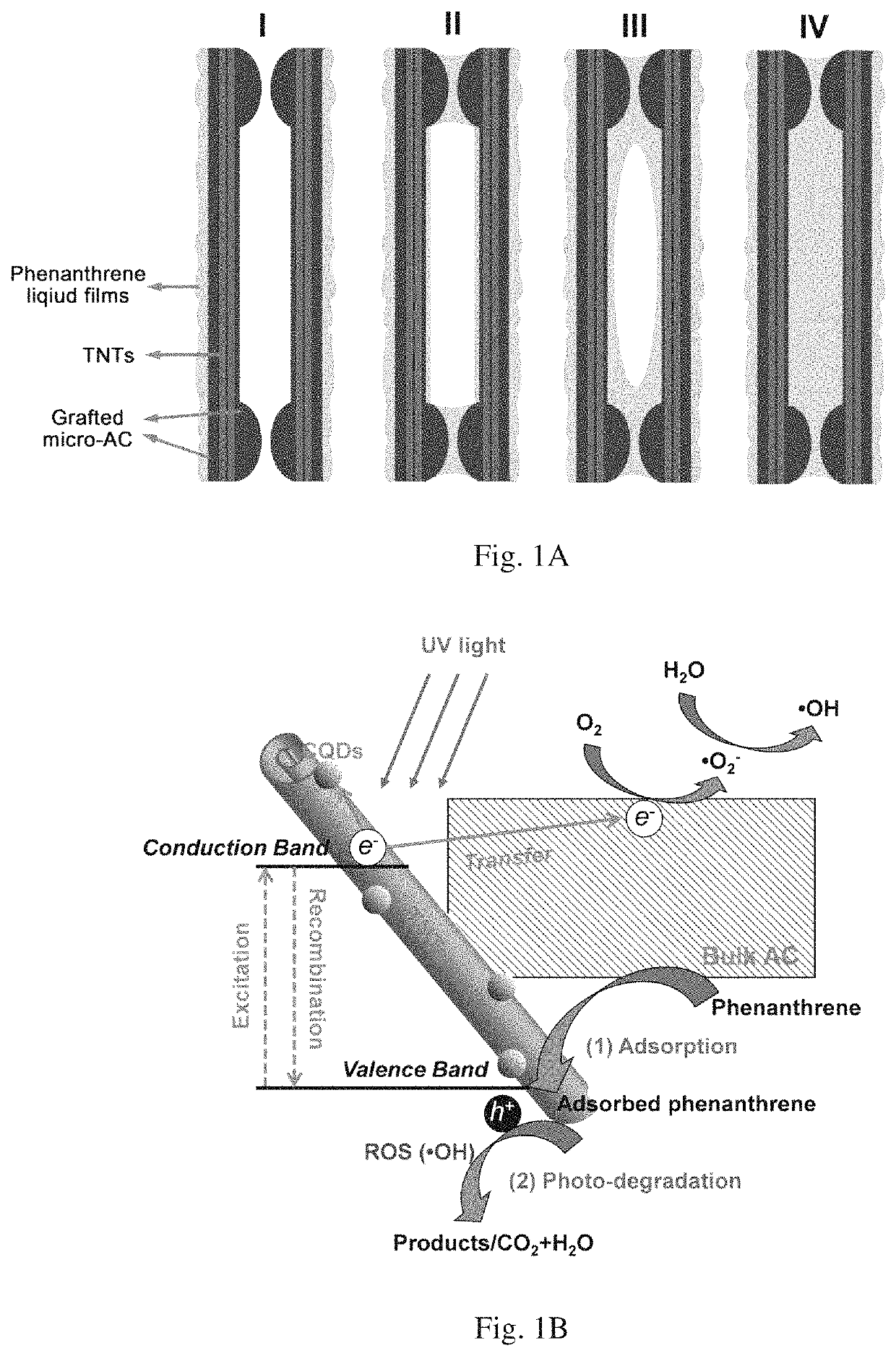Material for removing contaminants from water
a technology of contaminants and carbonaceous supports, applied in the direction of catalyst activation/preparation, metal/metal-oxide/metal-hydroxide catalysts, combustion gas purification/modification, etc., can solve the problems of poor regeneration, limited adsorption and oxidation, and conventional technologies such as adsorption and oxidation are often limited, and achieve high adsorption capacity, superior photocatalytic activity, and rapid adsorption rate
- Summary
- Abstract
- Description
- Claims
- Application Information
AI Technical Summary
Benefits of technology
Problems solved by technology
Method used
Image
Examples
example 1
Synthesis of TNTs@AC
[0170]Approximately 2.4 g AC and 1.2 g TiO2 were combined with 66.7 mL of a 10 mol / L NaOH solution. After stirring for 12 hours, the mixture was transferred into a Teflon reactor with a stainless steel cover and then heated at 130° C. for 72 hours. The black precipitate (TNTs@AC) was then separated and washed with deionized (DI) water until pH ˜7.5-8.5, and then dried at 80° C. for 4 hours. For comparison, plain TNTs were also prepared separately via the same procedure but without AC, and a sample of amended AC was also prepared by subjecting the parent AC to the same hydrothermal treatment without TiO2.
example 2
Analysis of TNTs@AC
[0171]Scanning electron microscope (SEM) images of the parent AC and TNTs@AC are shown in FIGS. 2A-2C. While the surface of AC appeared bulky, flat and smooth (FIG. 2A), the surface of TNTs@AC appeared rather rough and full of clusters of aggregates (FIG. 2B). A close-up of the surface revealed that the tubular TNTs formed an interweaved network spreading throughout the surface (FIG. 2C). The length of the nanotubes stretched up to hundreds of nanometers. The energy-dispersive X-ray spectra (EDS) (FIGS. 2D, 2E) reveal four major elements C, O, Na and Ti on the surface of TNTs@AC, indicating that TNTs were not just simply coated on AC, rather the nanotubes are intermingled with AC, i.e., some AC is also coated on TNTs.
[0172]FIG. 7 shows the X-ray diffractometer (XRD) patterns of neat TNTs, AC, and TNTs@AC. For neat TNTs, the peak at 9.4°, 24.4°, 28.1°, 48.2° and 61.5° are all assigned to sodium tri-titanate, with a basic structure of NaxH2-xTi3O7 (x=0-0.75, dependi...
example 3
[0177]The hydrothermal treatment and loading of TNTs lowered the measured BET surface area from 566.1 m2 / g for AC to 471.6 m2 / g for TNTs@AC and the pore volume from 0.61 to 0.52 cm3 / g (Table 3).
[0178]
TABLE 3Physicochemical properties of AC and TNTs@AC.BETSingleAveragePointsurfacepoint totalporeof zeroareapore volumediameterchargeMaterial(m2 / g)(cm3 / g)(nm)(pHPZC)TNTs@AC471.60.523.743.1AC566.10.614.276.8TNTs272.31.2618.62.6
[0179]The N2 adsorption-desorption isotherms for both AC and TNTs@AC conformed to the type IV isotherm with the H3 hysteresis loop (FIG. 10A), suggesting the presence of mesopores (2-50 nm) in the materials, which is also shown in FIG. 10B of the pore size distribution. FIGS. 10A and 10B also reveal that the hydrothermal treatment transformed the larger pores (>6 nm) in both TNTs and AC into smaller pores centered around ˜4 nm in TNTs@AC.
[0180]Considering the compositions of TNTs@AC (AC:TNTs mass ratio of 1.7:1) and the specific surface area of ...
PUM
| Property | Measurement | Unit |
|---|---|---|
| 2θ | aaaaa | aaaaa |
| 2θ | aaaaa | aaaaa |
| 2θ | aaaaa | aaaaa |
Abstract
Description
Claims
Application Information
 Login to View More
Login to View More - R&D
- Intellectual Property
- Life Sciences
- Materials
- Tech Scout
- Unparalleled Data Quality
- Higher Quality Content
- 60% Fewer Hallucinations
Browse by: Latest US Patents, China's latest patents, Technical Efficacy Thesaurus, Application Domain, Technology Topic, Popular Technical Reports.
© 2025 PatSnap. All rights reserved.Legal|Privacy policy|Modern Slavery Act Transparency Statement|Sitemap|About US| Contact US: help@patsnap.com



